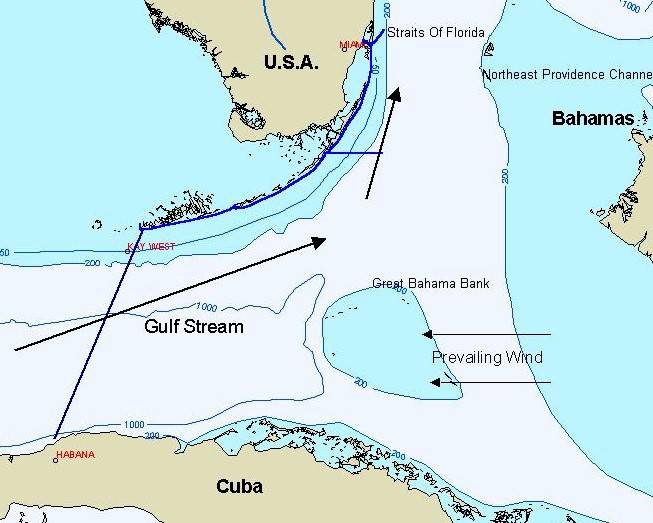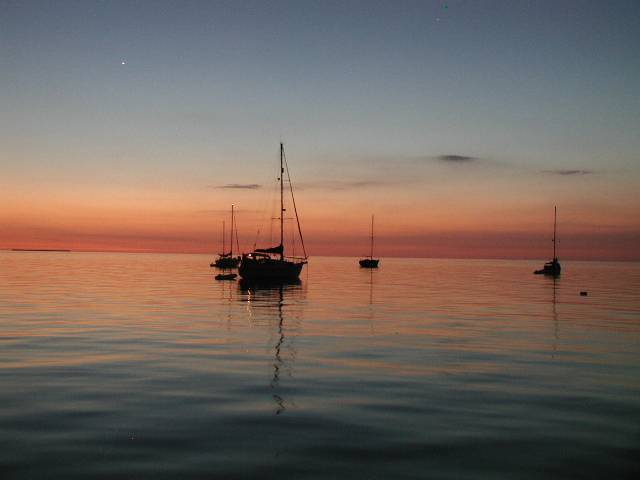Passage from Cuba to Key West, United States of America
9 -10th May 2004

Half way through this task, the motor decided to cut out but we finally managed to get things untangled, reef the genoa and get under sail again. Of course, Phil then had to go down into the engine room and bleed the engine, not a pleasant task at sea in rough conditions, made worse when the engine room fell off its slider and landed on top of him. A short time later, the engine was ready for action again and the engine room door was passing its time on our bed, until things calmed down a bit. The first time we've been envious of a door!
Next, we noticed a ship on our radar which seemed not to be moving and to which we were creeping ever closer. Finally, worried about the risk of collision, we managed to hail them by VHF, only to be told they were "just drifting until 22.30 hours, when they would make for port". As we were forced to tack to avoid them, we found ourselves impolitely wishing they'd picked another spot in which to drift. Eventually we were able to tack back on course and as we hauled in the genoa sheet, the port winch seized up, leaving us unable to haul in the sail as needed for beating.
We decided if we ran the sheet across the cockpit, we could use the starboard winch to harden the sail. Christine went to turn on the cockpit light in preparation, one hand in sodden sailing glove on the light switch, the other used to steady herself by holding on to the steel of the cockpit. Twelve volts passed up one arm and down the other until it reached the steel, then the cockpit light stopped working for good. Fumbling around in the gloom of a torch we managed to get the job done.
Finally after midnight, things began to calm down a little to a more manageable 20 knots, we ate the sandwiches we'd prepared for dinner and Phil was able to rest after his exertions in the engine room.
By dawn we were approaching the Florida Keys, where the water gets pretty shallow but we were out of the influence of the Gulf Stream. The approach to Key West is an area of small islands and reefs but luckily the channel is well-buoyed. Very luckily it turned out! We didn't have the USA charts for our dedicated chart plotter and were relying on the charting software we have on our PC. We'd (not surprisingly) been unable to obtain paper charts of Florida in Cuba before we left, but some friendly Venezuelans we'd met had kindly donated some paper charts they had used. These charts were definitely not Admiralty quality but were fine as a back-up. We ended up making our approach using those charts when first the DC adapter for our PC stopped working, followed by the DC to AC inverter, leaving us unable to power the PC. We later realised that they'd both been unable to cope with the higher voltage produced when the engine was running.
When we finally neared Key West, we were advised by a local to use an anchorage behind Wisteria Island (confusingly known locally as Christmas Tree Island). We didn't have a complete chart of that anchorage but it was just around the other side of the island from our position, so we stressed ourselves out by feeling our way between shallow spots, using the depth sounder.

At last, the tranquility of Key West's anchorage.
Captain was soon back. The first office he'd visited was Immigration, who wanted to see all the crew, so he had to dinghy the mile back out to the anchorage to collect the crew who wasn't allowed ashore. We'd been nervous about clearing into the States when arriving directly from Cuba but had no problems whatsoever, despite all the cruisers' horror stories we'd been told. By two pm Anju and her crew were legally in the States and very happy to be there!